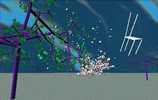
Catalogue Essay

|
|||
| Australian
Perspecta 1991 Catalogue Essay |
|||
|
In this work, Jon McCormack is exploring the possibilities and the limitations of a machine. It is a machine with which most of us have some contact every day of our lives. Whether it be at a supermarket checkout, an automatic teller, or an amusement centre, the computer has become an indispensible part of the Western economy. It bears a similar relationship in our society, to the role of the slave in ancient (and even some modern) societies. It has in its care a whole sector of tasks which have been deemed 'programmable'. Like a slave, it has no free will, it can make mistakes, and it can die. Unlike a slave it cannot feel or think for itself. It is literally only as imaginative as its master. The master in the computer sense is not simply the operator, but a community of human minds which have engineered the hardware, and developed the software. This definition of the 'master' and 'operator' is starkly expressed in this work. The decisions being made by this computer are not the decisions of the viewer. They are not the decisions of any one person. They are the decisions of a collective human mind in tandem with a natural occurence, that is, the prevailing weather conditions. Information from the environment outside, such as wind speed, direction and air temperature is codified (made understandable to the computer) and converted into visual information, which is displayed on the screen. The 'operator', is the physical weather conditions, while the 'master' or 'masters' are the developers of the 'hardware': (which includes a high performance 3D graphics computer; sensing devices which measure wind speed and direction, temperature and light levels; and video and audio equipment to display the results), and the 'software': (which includes pre-existing routines as well as new 'customised' routines developed by the artist). With Four Imaginary Walls, we watch the weather in a way denied to us by weather indicators of the past. A flag or leaves being blown around are good indicators of wind but give litle indication of heat. The effects of the real wind, temperature and light create a sculpture made from virtual objects. These objects are refered to as 'virtual ' because they could never exist in our reality. Their physics, mass, shape, colour, energy and behaviour are described within the computer software. No two objects have exactly the same properties. The objects themselves are cubic in shape and become more energetic as the temperature increases. They are extremely light and are attracted to each other when at close distances. They have knowledge of their environment and of each other. They are contained within a limited space by four imaginary walls which are not visible to the viewer - only their physical properties can be felt. The work presents itself at a number of levels. In its simplest form it reflects on the way physical forces and properties effect structure and form. Beyond this, it explores the notions of containment and the increasingly blurred relation between nature and machine. An analagous situation to that enacted here is the example of the crash of the financial markets of 1987. In that situation, the computers, which again had been programmed to respond to the prevaling 'weather conditions' of Wall Street, reacted in the only way they 'knew'. The 'viewing public' which included everyone from stockbrokers to the President, could only watch. The 'masters' had already done the thinking and the creating, and in a cruel irony of history, repeated through a machine an exact replica of the collective human reactions which caused the financial crash of sixty years earlier. Virtual environments allow sculptures and artists to work with materials and situations that could never exist in reality. However, this new 'reality' which has been created, amounts to a super-set of our own physics. It can be seen as another 'world', but its complexity, function and behaviour are minor subsets of what we know to be 'reality'. Its processes, patterns and forms suggest that both worlds share the same foundations. The important step is that what was previously hidden in formuli and theory can now now be 'viewed'.
14/6/91 |